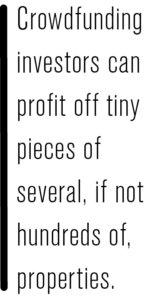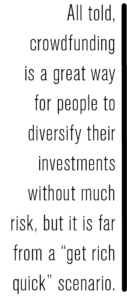Crowdfunding investments offers those who may not have the capital the opportunity to get involved
By Jason Henninger
Crowdfunding—gaining the capital for a particular project through multiple small investments rather than a few large investments—isn’t new. During WWII, the government sold war bonds—one of the best-known crowdfunding efforts of the pre-internet era. The idea was that you’d invest a little bit in the country’s military efforts and then, after a set period of time, be able to recoup the cash with interest. Crowdfunding today generally follows a similar pattern, though the timing and method of repayment vary depending on what is being funded.
 This way of raising money has existed for hundreds of years in one form or another but didn’t become a widely available investment tool until the early 2000s. Online crowdfunding began as a way for fans to support their favorite artists or to give to a charitable cause but has morphed into its own category of investment strategy for a wide variety of nonprofit and for-profit ventures. In real estate, it is rapidly growing in popularity.
This way of raising money has existed for hundreds of years in one form or another but didn’t become a widely available investment tool until the early 2000s. Online crowdfunding began as a way for fans to support their favorite artists or to give to a charitable cause but has morphed into its own category of investment strategy for a wide variety of nonprofit and for-profit ventures. In real estate, it is rapidly growing in popularity.
The positives
The potential benefits are many. For the sponsor—the one with or seeking physical ownership of a property—it is a way to obtain funding for projects from sources beyond banks alone. For the investor, it allows for small investments, often from $500 to $5,000, far less than the cost—or potential risk—of full ownership.
This means investing in real estate becomes a possibility for people who don’t have the funds or the credit rating to purchase property in full. Crowdfunding investors can profit off tiny pieces of several, if not hundreds of, properties.
It’s also a passive investment, meaning it does not require the time and energy needed to maintain the property. Of course, the flip side of it being a passive investment is that, unlike traditional real estate investments, the crowdfunding investor has no control over the property or its development.
 The negatives
The negatives
These benefits are enticing, but a potential investor should be aware that while the amount of capital needed is small, the return can also be relatively small compared to the money one might make from fully owning property.
Further, these investments generally cannot be cashed out quickly if needed. This is true of real estate in general, but particularly so with crowdfunding. All told, crowdfunding is a great way for people to diversify their investments without much risk, but it is far from a “get rich quick” scenario.
Where to invest
Numerous real estate crowdfunding platforms are available to accredited investors (those with at least $1 million net worth or able to meet other high annual income requirements) or non-accredited (general public). Each real estate crowdfunding company has its own way of doing business, charging service fee percentages, or fixed price fees or charging the sponsors. In some cases, the crowdfunding company itself is the sponsor. They vary in how they pay out, too.
For the new investor, especially a non-accredited one, such opportunities present an enticing way to get into a world previously unavailable to them. But in all cases, it’s best to thoroughly understand how the platforms work, looking not only at the minimum and fees but also at all the fine print. Even if the amount invested is small, it is still a real estate investment, with all the complexities that come with it.
Platforms for Crowdfunding Investments
The majority of crowdfunding sites work with commercial and residential properties. The array of real estate crowdfunding sites is growing and changing rapidly. Here are a few sites available for residential (single-family or multiple) crowdfunding, in no particular order.
Fundrise. It’s been around for about a decade, making it one of the oldest sites in this rather new field. They are open to non-accredited investors and offer opportunities to invest in everything from industrial complexes to individual homes, with low minimum investments.
Arrived. Unlike sites that offer investments for real estate investment trusts (REITs) and large commercial properties, Arrived focuses exclusively on the residential side. They offer low minimums, available to non-accredited investors, though as a new company, they don’t always have a wide selection to choose from.
Lofty. Offering low minimums and an unusual daily dividend frequency (quarterly is far more common), Lofty works with single-family rentals and mixed-use commercial in a fractional ownership model. They’ve been around since 2018 and use blockchain to fractionalize investments.
Groundfloor. This site and app boast an average of 10% returns and $10 to get started. They have been around for about a decade, making it one of the older sites of this nature, along with Fundrise. The dividend frequency can depend on when a loan is fully funded, so investors may not always see investment returns on a predictable schedule.
Ark7. This site, like Lofty, offers fractional ownership of residential (single- and multi-family) properties with a quarterly dividend schedule. Ark7 prides itself on transparency, ensuring full legal and financial disclosure and no hidden fees.
Enroll in our eLearning course, Strategies to Help Finance and Grow Your Real Estate Business, at CRS.com/catalogsearch.
Photo: iStock.com/AndreyPopov








